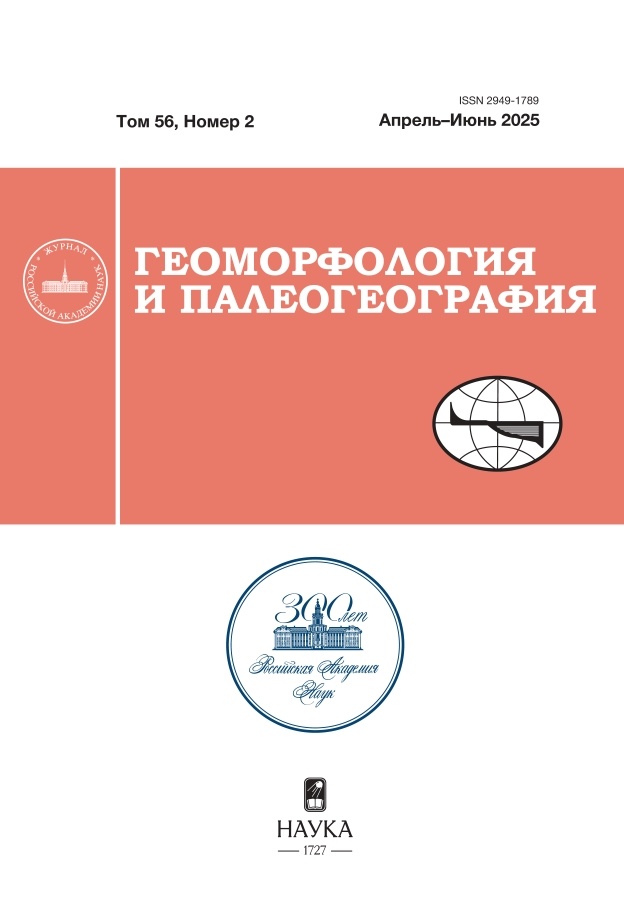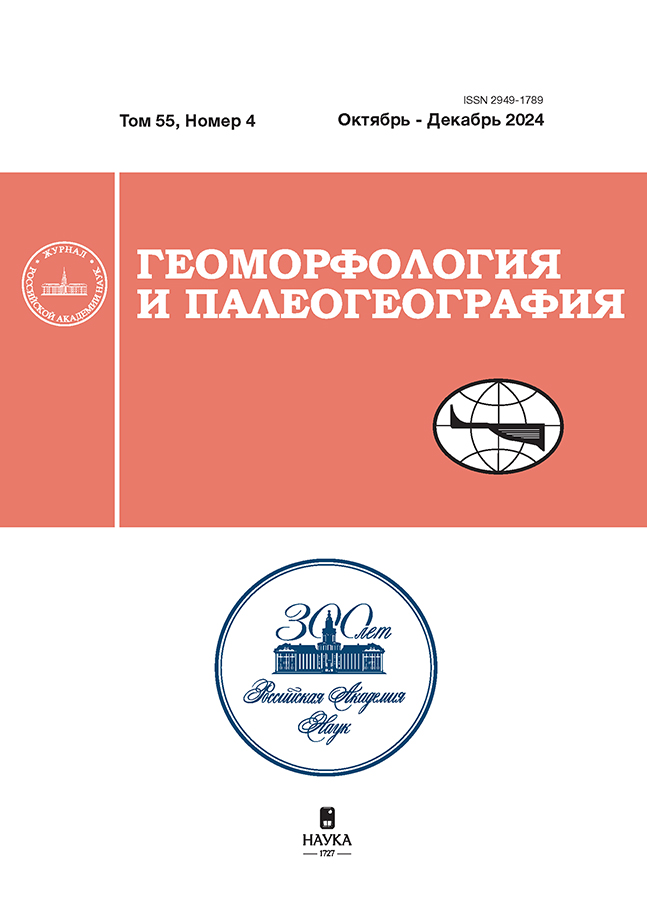Распространение и морфометрические характеристики чётковидных русел северной части степной зоны Русской равнины
- Авторы: Камышев А.А.1, Куракова А.А.1, Тарбеева А.М.1
-
Учреждения:
- Московский государственный университет имени М.В. Ломоносова, географический факультет
- Выпуск: Том 55, № 4 (2024)
- Страницы: 129-143
- Раздел: ЭКЗОГЕННАЯ ГЕОМОРФОЛОГИЯ
- URL: https://medjrf.com/2949-1789/article/view/682342
- DOI: https://doi.org/10.31857/S2949178924040089
- EDN: https://elibrary.ru/FGBFIS
- ID: 682342
Цитировать
Полный текст
Аннотация
Чётковидными называются русла, в которых на значительном протяжении реки следуют друг за другом округлые в плане расширения русла в пределах бровок пойменных яров. Они широко распространены в криолитозоне и в степи и являются специфическим малоисследованным морфодинамическим типом русел. В условиях криолитозоны происхождение таких русел считается эрозионно-термокарстовым, но механизмы образования расширений русел в степи до сих пор дискутируются. Даже на смежных территориях их объясняют разными причинами: криогенными реликтами позднего неоплейстоцена, неравномерным заилением и другими процессами. В данной работе была проведена оценка частоты встречаемости чётковидных русел в районах севера степной зоны ЕТР. Анализировалось их распространение на малых реках Хопёрско-Бузулукской равнины и Калачской возвышенности. На одной из типичных малых рек – Кардаиле – проведен морфометрический анализ параметров русла. Выявлено, что чётковидные русла характерны для степных рек с площадями водосбора от 44 км² до 9000 км², и формируются в диапазоне уклонов от 0.26 м/км до 1.35 м/км. При площадях водосбора более 1600 км² чётки наблюдаются только в разветвленных руслах, пойменных протоках и старицах. В неразветвленном русле чётки наблюдаются в пределах излучин, у которых соотношение шага к ширине русла больше 10, а на берегах отсутствуют следы активной динамики русла. Общая протяженность чётковидного русла может достигать 80% длины реки. Выделено два типа чёток, различающихся по размерам, расположению в русле и выраженности в пределах бровок высокой или низкой поймы. Чётки, выраженные только в бровках низкой поймы, вероятно связаны с неравномерным зарастанием деградирующего русла и образованием молодой поймы, тогда как чётки, выраженные в бровках более высоких уровней пойме вероятнее всего сформированы внешними факторами – криогенными или суффозией.
Ключевые слова
Полный текст
Открыть статью на сайте журналаОб авторах
А. А. Камышев
Московский государственный университет имени М.В. Ломоносова, географический факультет
Автор, ответственный за переписку.
Email: arsenii.kamyshev@yandex.ru
Россия, Москва
А. А. Куракова
Московский государственный университет имени М.В. Ломоносова, географический факультет
Email: a.a.kurakova@mail.ru
Россия, Москва
А. М. Тарбеева
Московский государственный университет имени М.В. Ломоносова, географический факультет
Email: amtarbeeva@yandex.ru
Россия, Москва
Список литературы
- Белоцерковский М.Ю., Докудовская О.Г., Кирюхина З.П. и др. (1983). Количественная оценка эрозионноопасных земель бассейна Дона. В сб.: Эрозия почв и русловые процессы. Вып. 9. С. 23–41.
- Беляев Ю.Р., Панин А.В., Бронникова М.А. и др. (2021). История формирования рельефа западной части Турано-Уюкской котловины (Тувинское нагорье) в позднем плейстоцене. Геоморфология. № 4. С. 15–27. https://doi.org/10.31857/S0435428121040040
- Величко А.А. (2002). Динамика ландшафтных компонентов и внутренних морских бассейнов Северной Евразии за последние 130 000 лет. Атлас-монография. М.: ГЕОС. 231 с.
- Голосов В.Н. (2006). Эрозионно-аккумулятивные процессы в речных бассейнах освоенных равнин. М.: ГЕОС. 296 с.
- Государственная геологическая карта Российской Федерации 1 : 1 000 000 (третье поколение) Серия Центрально-Европейская. Лист М-38. Волгоград. Объяснительная записка. (2009). Под ред. С.И. Застрожнова. СПб.: Картфабрика ВСЕГЕИ. 399 c.
- Григорьев А.А. (1927). Геоморфологический очерк Якутии. Л.: Изд-во АН СССР. 52 c.
- Губарьков А.А., Лейбман М.О. (2010). Чёткообразные русловые формы в долинах малых рек на Центральном Ямале – результат парагенеза криогенных и гидрологических процессов. Криосфера Земли. Т. XIV. № 1. С. 41–49.
- Иванова Н.Н., Голосов В.Н., Панин А.В. (1996). Земледельческое освоение территории и отмирание рек Европейской части России. Геоморфология. № 4. С. 53–60.
- Кичигин А.Н. (1992). Причины деградации русел малых рек Вологодской области. Геоморфология. № 1. С. 56–62.
- Кондратьев Н.Е., Попов И.В., Снищенко Б.Ф. (1982). Основы гидроморфологической теории руслового процесса. Л.: Гидрометеоиздат. 272 с.
- Лобанова Н.А. (2014). Особенности сельскохозяйственного районирования Волгоградской области. Электронный научно-образовательный журнал ВГСПУ “Грани познания”. № 4 (31). [Электронный ресурс] URL: www.grani.vspu.ru (дата обращения 30.09.2023)
- Основные гидрологические характеристики водных объектов бассейна реки Дон: научно-прикладной справочник. (2020). Под ред. В. Ю. Георгиевского. СПб.: Свое издательство. 262 с.
- Панин А.В., Иванова Н.Н., Голосов В.Н. (1997). Речная сеть и эрозионно-аккумулятивные процессы в бассейне Верхнего Дона. Водные ресурсы. Т. 24. № 6. С. 663–671.
- Панин А.В., Сидорчук А.Ю., Власов М.В. (2013). Мощный поздневалдайский речной сток в бассейне Дона. Известия РАН. Серия географическая. № 1. С. 118–129. https://doi.org/10.15356/0373-2444-2013-1-118-129
- Панин А.В., Сидорчук А.Ю., Чернов А.В. (2011). Основные этапы формирования пойм равнинных рек Северной Евразии. Геоморфология. № 3. С. 20–31. https://doi.org/10.15356/0435-4281-2011-3-20-31
- Рябуха А.Г., Поляков Д.Г. (2020). Особенности распространения, морфологическое строение и механизмы формирования чётковидных русел малых рек степной зоны Оренбургской области. Успехи современного естествознания. № 4. C. 146–150.
- Свод правил СП 131.13330.2020. СНиП 23-01-99* Строительная климатология. (2020). М.: Министерство строительства и жилищно-коммунального хозяйства Российской Федерации. https://www.minstroyrf.gov.ru/upload/iblock/82b/SP-131.pdf
- Тарбеева А.М., Крыленко И.В., Сурков В.В. (2016). Озеровидные расширения русел рек степной зоны и возможные причины их формирования (бассейн р. Урал в районе г. Орска). Геоморфология. № 1. С. 73–81. https://doi.org/10.15356/0435-4281-2016-1-73-81
- Тарбеева А.М., Крыленко И.В., Сурков В.В. и др. (2024). Современные процессы в чётковидных руслах степных рек Хопёрско-Бузулукской равнины. Вестник МГУ. Сер. 5. География. № 3. С. 136–149. https://doi.org/10.55959/MSU0579-9414.5.79.3.11
- Тарбеева А.М., Лебедева Л.С., Ефремов В.С. и др. (2019). Условия и процессы формирования чётковидной формы русла малой реки криолитозоны (на примере р. Шестаковки, Центральная Якутия). Криосфера Земли. Т. 23. № 2. С. 38–49. https://doi.org/10.21782/KZ1560-7496-2019-2(38-49)
- Тарбеева А.М., Сурков В.В. (2013). Чётковидные русла малых рек зоны многолетней мерзлоты. География и природные ресурсы. № 3. С. 27–32.
- Хоменко В.П. (2003). Закономерности и прогноз суффозионных процессов. М.: ГЕОС. 216 с.
- Чалов Р.С. (2008). Русловедение: теория, география, практика. Т. 1. Русловые процессы: факторы, механизмы, формы проявления и условия формирования речных русел. М.: Изд-во ЛКИ. 608 с.
- Чалов Р.С. (2011). Русловедение: теория, география, практика. Т. 2: Морфодинамика речных русел. М.: КРАСАНД. 960 с.
- Чалов Р.С., Алабян А.М., Иванов В.В. и др. (1998). Морфодинамика русел равнинных рек. М.: ГЕОС. 288 с.
- Чалов Р.С., Ботавин Д.В., Варёнов А.Л. и др. (2018). Формирование русел малых рек Приволжской возвышенности в условиях многовекового сельскохозяйственного освоения. География и природные ресурсы. Вып. 3. С. 86–94. https://doi.org/10.21782/GIPR0206-1619-2018-3(86-94)
- Чернов А.В. (1988). Современное развитие малых рек центральных районов Европейской части СССР. В сб.: Малые реки Центра Русской равнины, их использование и охрана. М.: МО ГО СССР. С. 17–25.
- Шайдеггер А.Е. (1964). Теоретическая геоморфология. М.: Прогресс. 450 с.
- Arp C.D., Whitman M., Jones B. et al. (2015). Distribution and biophysical processes of beaded streams in Arctic permafrost landscapes. Biogeosciences. V. 12. Iss. 1. P. 29–47. https://doi.org/10.5194/bg-12-29-2015
- Hopkins, D.M., Karlstrom, T.N.V., Black, R.F. et al. (1955). Permafrost and ground water in Alaska. U.S. Geol. Surv. Prof. Pap. 264 F. Washington, USA. 146 p.
- Leopold L.B., Wolman M.G. (1957). River channel patterns – braided, meandering and straight. U.S. Geol. Surv. Prof. Pap. 282-B. Washington, USA. 85 p.
- Mould S., Fryirs K. (2017). The Holocene evolution and geomorphology of a chain of ponds, southeast Australia: Establishing a physical template for river management. Catena. V. 149. Part 1. P. 349–362. http://dx.doi.org/10.1016/j.catena.2016.10.012
- Rosgen D.L. (1994). A classification of natural rivers. Catena. V. 22. Iss. 3. P. 169–199. http://dx.doi.org/10.1016/0341-8162(94)90001-9
- Williams R.T., Fryirs K.A. (2020). The morphology and geomorphic evolution of a large chain-of-ponds river system. Earth Surf. Process. Landforms. V. 45. Iss. 8. P. 1732–1748. https://doi.org/10.1002/esp.4842
Дополнительные файлы


















